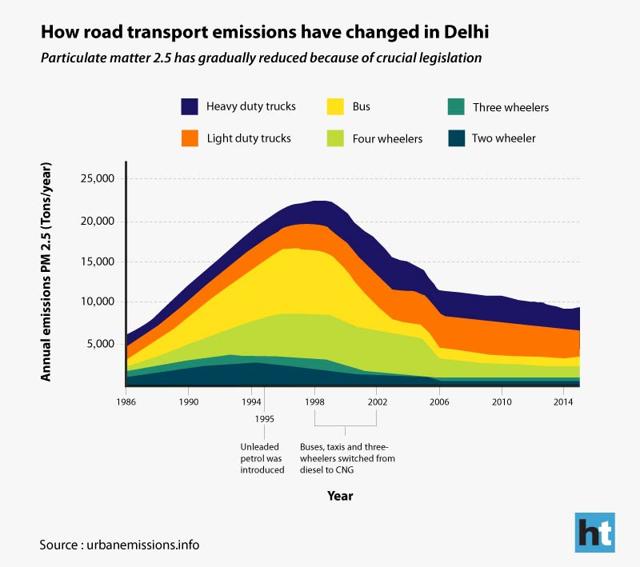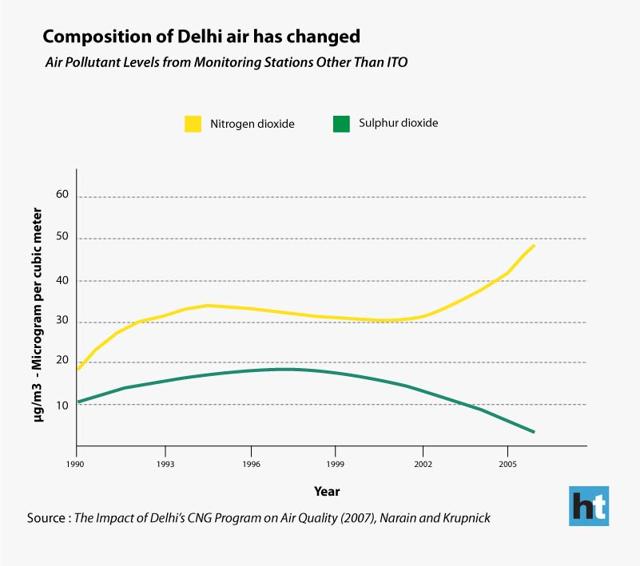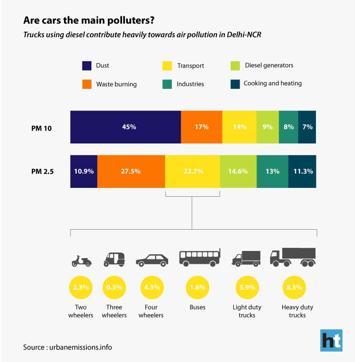A history of Delhi’s air pollution: Can road rationing even the odds?
Delhi’s radical road rationing plan kicks in from the new year as a desperate city struggles to clean up its filthy air. A lungful of air in Delhi is a noxious mix of smoke, dust, fumes and ash with heavy concentrations of chemicals, acids, metals and carcinogens. What makes this “particulate matter” so deadly is its size - the particles are small enough to pass through the nose and throat, and even penetrate tissue. The tiniest, which are 2.5 micrometers or less in diameter (PM 2.5), are the worst. They are more toxic, travel farther from their source and live deep in lung tissue.
Delhi’s radical road rationing plan kicks in from the new year as a desperate city struggles to clean up its filthy air.

A lungful of air in Delhi is a noxious mix of smoke, dust, fumes and ash with heavy concentrations of chemicals, acids, metals and carcinogens. What makes this “particulate matter” so deadly is its size - the particles are small enough to pass through the nose and throat, and even penetrate tissue. The tiniest, which are 2.5 micrometers or less in diameter (PM 2.5), are the worst. They are more toxic, travel farther from their source and live deep in lung tissue.
Although Delhi’s (and India’s) air has gotten progressively worse - a 2014 report said air quality in the country has declined 100 percent in the last decade - contributions from different pollutants have shifted over the years.
What’s changed?
Particulate matter - PM 2.5 specifically - produced by vehicle emissions peaked around 1998. And then it started to gradually decline. That was when the Supreme Court ordered the city’s fleet of buses to switch from diesel to Compressed Natural Gas (CNG). Also included in the ruling were pre-1990 autorickshaws and taxis.

By this time, the Delhi government had passed a slew of other measures to cut emissions from vehicles. They introduced unleaded petrol as well as diesel and petrol with low levels of sulphur. This led to a drop in the levels of sulphur dioxide (SO2), and since the gas converts to fine particles, a drop in PM10.
But some studies argue that a lot of these gains have been reversed because of the sharp increase in the number of vehicles, especially those running on diesel. So Nitrogen Oxides and Ozone - by-products of emissions from cars, trucks, construction etc. - have been rising while other pollutants such as sulphur dioxides have reduced.

But vehicles aren’t the only culprits
Road dust - a term which refers to a high concentration of metals such as Copper, Manganese, Nickel, Barium, Zinc etc. is a major cause of particulate matter in Delhi. It’s the result of poor roads, heavy traffic and incessant construction.
An equally alarming cause is Delhi’s garbage - burning piles of trash are a source of particulate matter, mercury and other harmful chemicals. According to some estimates, burning trash produces nearly 30% of the world’s particulate matter and 40% of its Polycyclic aromatic hydrocarbons (PAHs), a class of chemicals associated with neurological diseases, heart attacks and cancer.

Pollution from industries might be lower than that from vehicles but they pose a major challenge for monitoring and enforcement. Industries in and around Delhi, many of them small-scale, have long been accused of flouting regulation and fudging data. For one, the instruments they use to monitor pollutants are rarely up to global standards because the manufacturers “self-certify” their products.
Delhi’s air is not that different from its neighbours. Emissions from brick kilns, coal plants, cement units, tanneries etc. in Faridabad, Haryana, Punjab and Uttar Pradesh send the most toxic particulate matter as far as the Capital. A recent study found that on the days PM 2.5 exceeded
120 micrograms per cubic metre in Delhi, 22% of it came from the south-southwest direction. That is, Faridabad and Gurgaon.
Finally, there’s geography. Yes, that matters. Chennai, for instance, has ten times more cars per kilometre of road length but a tenth of Delhi’s PM levels, according to some estimates. Why? Because as a coastal city that isn’t surrounded by dusty, industrial towns that are swiftly expanding, it can replace some of its polluted air with cleaner breeze from the sea. Delhi’s air also gets worse in winters when cool temperatures draw in more polluted air. It only gets a little better in the summer because dust aggravates pollution.
Will the odd even rule help?
It’s certainly a start. But, as the number suggest, if vehicles aren’t necessarily the worst polluters, Delhi needs more legislation to clean up its air.
This data from Urban Emissions.info is helpful to understand what effect new regulations, if passed, would have.



